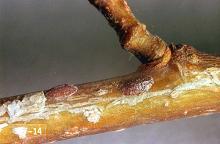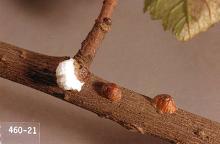Pulvinaria vitis
Pest description and crop damage This scale overwinters on grape canes as an immature stage that is brownish to black in color, 0.06 to 0.14 inch in length, and has a flat and oval outline. Scales attain a maximum length of about 0.25 inch during spring. The conspicuous, cottony egg sac of the mature stage is two to three times the length of the scale body. The insect feeds on foliage, reduces the vigor of the plant, and causes twig dieback. Feeding scales produce honeydew, which becomes a food source for ants and can grow sooty mold. Scout for noticeable presence of ants, as this may be the first sign that the scale is present on a vine.
Biology and life history Each female lays about 3,000 eggs. The egg sac remains for some time after the female has died and crawlers have dispersed to the undersides of leaves. Scales reach maturity in June, and crawlers appear in July and August. This pest has not been common in Oregon vineyards. Caution is to be taken with scale insects as they may vector certain grapevine viruses, such as grapevine leafroll virus.
Management-biological control
Although biological controls of cottony maple scale have not been studied, scale insects generally are preyed upon heavily by parasitic wasps.
Management-cultural control
Since much of the vine is removed at pruning, it may be unnecessary to apply control measures unless the scale is infesting the main trunk or cordons.
Management-chemical control: HOME USE
- Dormant-season spray
- horticultural oils-Some formulations are OMRI-listed for organic use.
Management-chemical control: COMMERCIAL USE
Scale insects can be difficult to control with contact insecticides because of their cryptic behavior. They are often found within crevices and under the bark. During the latter portion of the growing season, they can be found within clusters. All of these locations are difficult to reach when applying contact insecticides. Often, contact insecticides are the only viable option to control these insects. When using contact insecticides, make sure to get thorough coverage of the target (trunk or clusters). Systemic insecticides may be more effective because the insect is targeted at the feeding site because of uptake and systemic movement of the insecticide. However, be aware of the disadvantages associated with the use of systemic insecticides, such as effects on non-target insects.
- buprofezin (Applaud) at 0.53 lb ai/A. PHI 7 days. Do not exceed 1.05 lb ai/A per season. Allow at least 14 days between applications. Apply by ground using 50 to 200 gal/A water, depending on the size of the grape plants/canopy. Use higher water volume to ensure good coverage, especially under hot, dry weather and/or dense canopies. Do not exceed two applications per season. Although cottony grape scale insect is not listed on the label for grapes, it is an effective and legal use. Group 16 insecticide.
- horticultural oil (several brands)-Consult label for rate. Apply oil at a spray volume of 200 to 300 gal/A. Apply in late March or early April while vines are still dormant; do not apply oil after budbreak. Some formulations are OMRI-listed for organic use.
- imidacloprid (Admire Pro and other brands)-Consult label for rates and PHI based on how the product is applied for other scale insects. Scales are managed with soil applications, not foliar.
- spirotetramat (Movento) at 0.10 to 0.13 lb ai/A. PHI 7 days. Ensure that there is adequate foliage, allowing for absorption of the active ingredient. Allow 30 days between applications. Do not exceed 0.2 lb ai/A per season. Use a penetrating adjuvant to ensure adequate absorption (nonionic organosilicone); see label for more details on which adjuvants to use or avoid. Group 23 insecticide. Although scale insect is not listed under foliar applications for grape, it is a legal use and should be helpful in suppressing scale crawlers. Do not exceed 0.2 lb ai/A per year. Allow 14 days between applications.



